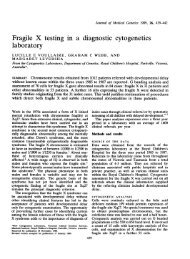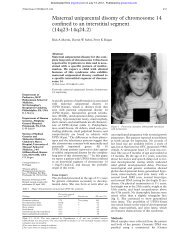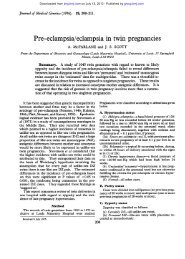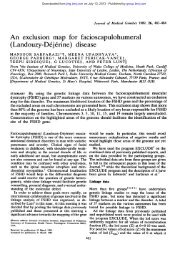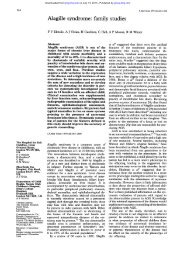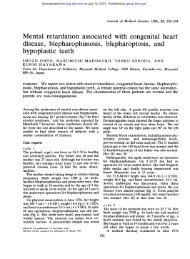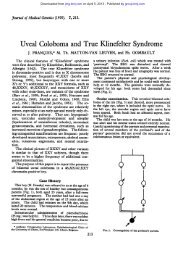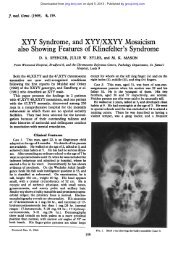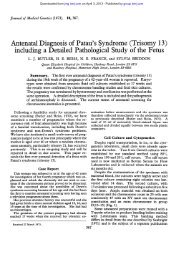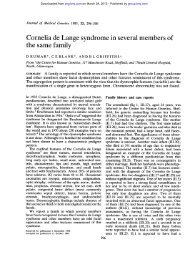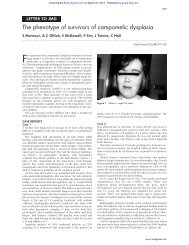Anticipation in Huntington's disease is inherited - Journal of Medical ...
Anticipation in Huntington's disease is inherited - Journal of Medical ...
Anticipation in Huntington's disease is inherited - Journal of Medical ...
You also want an ePaper? Increase the reach of your titles
YUMPU automatically turns print PDFs into web optimized ePapers that Google loves.
<strong>Journal</strong> <strong>of</strong> <strong>Medical</strong> Genetics 1988, 25, 589-595<br />
<strong>Anticipation</strong> <strong>in</strong> Hunt<strong>in</strong>gton's <strong>d<strong>is</strong>ease</strong> <strong>is</strong> <strong>in</strong>herited<br />
through the male l<strong>in</strong>e but may orig<strong>in</strong>ate <strong>in</strong> the female<br />
R M RIDLEY*, C D FRITH*, T J CROW*, AND P M CONNEALLYt<br />
From *the Div<strong>is</strong>ion <strong>of</strong> Psychiatry, Cl<strong>in</strong>ical Research Centre, Watford Road, Harrow, Middlesex HAI 3UJ;<br />
and tthe Department <strong>of</strong> <strong>Medical</strong> Genetics, Indiana University, Indianapol<strong>is</strong>, Indiana 46223, USA.<br />
SUMMARY Data from the US National Hunt<strong>in</strong>gton's D<strong>is</strong>ease Roster have been analysed <strong>in</strong><br />
terms <strong>of</strong> the difference <strong>in</strong> age <strong>of</strong> onset (AO) between affected parents and affected <strong>of</strong>fspr<strong>in</strong>g, that<br />
<strong>is</strong>, <strong>in</strong> terms <strong>of</strong> 'anticipation'. While mean AO <strong>in</strong> <strong>of</strong>fspr<strong>in</strong>g <strong>of</strong> affected mothers did not differ<br />
greatly from AO <strong>in</strong> their mothers, the d<strong>is</strong>tribution <strong>of</strong> AO <strong>in</strong> the <strong>of</strong>fspr<strong>in</strong>g <strong>of</strong> affected fathers falls<br />
<strong>in</strong>to two groups, the larger group show<strong>in</strong>g an AO only slightly younger than their affected fathers<br />
and a small group whose AO was, on average, 24 years younger than their affected fathers.<br />
Analys<strong>is</strong> <strong>of</strong> the grandparental orig<strong>in</strong> <strong>of</strong> the Hunt<strong>in</strong>gton allele suggests that while propensity to<br />
anticipation <strong>is</strong> heritable for a number <strong>of</strong> generations through the male l<strong>in</strong>e, it orig<strong>in</strong>ates at the<br />
time <strong>of</strong> differentiation <strong>of</strong> the germ l<strong>in</strong>e <strong>of</strong> a male who acquires the Hunt<strong>in</strong>gton allele from h<strong>is</strong><br />
mother. It <strong>is</strong> suggested that major anticipation <strong>in</strong>dicates an epigenetic change <strong>in</strong> methylation <strong>of</strong><br />
the nucleic acid <strong>of</strong> the genome, which <strong>is</strong> imposed <strong>in</strong> the course <strong>of</strong> the 'genomic impr<strong>in</strong>t<strong>in</strong>g', that<br />
<strong>is</strong>, <strong>in</strong> the mechan<strong>is</strong>m by which the parental orig<strong>in</strong> <strong>of</strong> alleles <strong>is</strong> <strong>in</strong>dicated.<br />
<strong>Anticipation</strong> <strong>is</strong> the term used to describe the<br />
tendency for the age <strong>of</strong> onset (AO) <strong>of</strong> a dom<strong>in</strong>antly<br />
<strong>in</strong>herited d<strong>is</strong>order to be younger <strong>in</strong> the proband than<br />
<strong>in</strong> the affected parent. We have analysed data from<br />
the US National Hunt<strong>in</strong>gton's D<strong>is</strong>ease Roster and<br />
found that, while anticipation <strong>in</strong> the maternal l<strong>in</strong>e <strong>is</strong><br />
not greatly <strong>in</strong> excess <strong>of</strong> that predicted by normal<br />
variation and shows typical regression to the mean<br />
(such that <strong>of</strong>fspr<strong>in</strong>g <strong>of</strong> mothers with young AO show<br />
negative anticipation), anticipation <strong>in</strong> the paternal<br />
l<strong>in</strong>e <strong>is</strong> notably skewed and positive across all AOs <strong>of</strong><br />
the father. Although the propensity to anticipation<br />
<strong>is</strong> heritable through the male l<strong>in</strong>e, analys<strong>is</strong> <strong>of</strong> the<br />
grandparental orig<strong>in</strong> <strong>of</strong> the gene suggests that it<br />
orig<strong>in</strong>ates <strong>in</strong> transm<strong>is</strong>sion from a female. While<br />
anticipation which occurs when the gene has been<br />
<strong>in</strong>herited from a grandfather and father <strong>is</strong> uniformly<br />
d<strong>is</strong>tributed with respect to AO <strong>in</strong> the father,<br />
Hunt<strong>in</strong>gton's <strong>d<strong>is</strong>ease</strong> (HD) which has been <strong>in</strong>herited<br />
from a grandmother and father shows positive<br />
rather than negative anticipation <strong>in</strong> the <strong>of</strong>fspr<strong>in</strong>g <strong>of</strong><br />
fathers with young AO. S<strong>in</strong>ce no unusual change <strong>in</strong><br />
AO <strong>is</strong> seen when the gene <strong>is</strong> transmitted through a<br />
mother it appears that the propensity to anticipation<br />
<strong>is</strong> corrected by such transm<strong>is</strong>sion. We <strong>in</strong>terpret<br />
these changes as show<strong>in</strong>g that anticipation <strong>in</strong> HD <strong>is</strong><br />
determ<strong>in</strong>ed by an epigenetic change related to the<br />
Received for publication 25 November 1987.<br />
Rev<strong>is</strong>ed version accepted for publication 1 February 1988.<br />
Downloaded from<br />
jmg.bmj.com on March 23, 2013 - Publ<strong>is</strong>hed by group.bmj.com<br />
pattern <strong>of</strong> methylation <strong>of</strong> the nucleic acid sequence<br />
which <strong>is</strong> imposed <strong>in</strong> the course <strong>of</strong> 'genomic<br />
impr<strong>in</strong>t<strong>in</strong>g'.' Specifically, an epigenetic change<br />
lead<strong>in</strong>g to major anticipation <strong>in</strong> affected <strong>of</strong>fspr<strong>in</strong>g <strong>of</strong><br />
affected males occurs dur<strong>in</strong>g the process <strong>of</strong> differentiation<br />
<strong>of</strong> the germ cells (spermatogonia) <strong>of</strong><br />
male embryos when the HD gene <strong>is</strong> <strong>in</strong>herited from a<br />
mother s<strong>in</strong>ce th<strong>is</strong> requires a methylation change.<br />
Such an epigenetic error can then be <strong>in</strong>herited<br />
<strong>in</strong>def<strong>in</strong>itely through the male l<strong>in</strong>e caus<strong>in</strong>g anticipation<br />
<strong>in</strong> <strong>of</strong>fspr<strong>in</strong>g <strong>of</strong> either sex, but when the HD<br />
gene next passes through a female, genomic impr<strong>in</strong>t<strong>in</strong>g<br />
<strong>in</strong> her germ cells (oogonia) remethylates the HD<br />
gene and thereby corrects the error.<br />
<strong>Anticipation</strong> <strong>is</strong> usually regarded as be<strong>in</strong>g the<br />
product <strong>of</strong> various possible ascerta<strong>in</strong>ment biases,<br />
although some ascerta<strong>in</strong>ment biases would work<br />
aga<strong>in</strong>st the observation <strong>of</strong> anticipation (table 1).<br />
Most ascerta<strong>in</strong>ment biases could occur irrespective<br />
<strong>of</strong> whether the <strong>d<strong>is</strong>ease</strong> was <strong>in</strong>herited from the father<br />
or the mother, although the loss <strong>of</strong> affected pairs<br />
show<strong>in</strong>g anticipation because the obligate carrier<br />
parent has died or lost contact with the proband<br />
before onset <strong>of</strong> illness <strong>in</strong> the parent may apply<br />
particularly to pairs where the <strong>d<strong>is</strong>ease</strong> <strong>is</strong> <strong>in</strong>herited<br />
from the father. Thus, one might expect that the<br />
phenomenon <strong>of</strong> anticipation, if it occurs as a<br />
consequence <strong>of</strong> ascerta<strong>in</strong>ment bias, would be<br />
equally apparent <strong>in</strong> father/<strong>of</strong>fspr<strong>in</strong>g and mother/<br />
589
590<br />
Downloaded from<br />
jmg.bmj.com on March 23, 2013 - Publ<strong>is</strong>hed by group.bmj.com<br />
TABLE 1 Ascerta<strong>in</strong>ment bias produc<strong>in</strong>g anticipation.<br />
(I) At any one time. family data will <strong>in</strong>clude young people with a young AO<br />
but will exclude those <strong>of</strong> their sibs who will have an older AO but who arc<br />
not yet affected.<br />
(2) Onset <strong>of</strong> illness may be <strong>in</strong>sidious and where <strong>d<strong>is</strong>ease</strong> has occurred recently<br />
<strong>in</strong> a parent the symptoms may be recogn<strong>is</strong>ed at an earlier stage <strong>in</strong> the<br />
<strong>of</strong>fspr<strong>in</strong>g. Th<strong>is</strong> source <strong>of</strong> bias <strong>is</strong> likely to be particularly important <strong>in</strong><br />
families <strong>in</strong> which some members have become affected s<strong>in</strong>ce the family has<br />
enrolled <strong>in</strong> the HD Roster.<br />
(3) People with a very young AO have no children and therefore do not<br />
appear <strong>in</strong> the parental group.<br />
(4) Parents with a young AO died when the proband was a child and cause and<br />
age <strong>of</strong> death <strong>in</strong> the parent <strong>is</strong> not known to the child.<br />
(5) The older the AO <strong>in</strong> the <strong>of</strong>fspr<strong>in</strong>g, the greater the probability that the<br />
<strong>of</strong>fspr<strong>in</strong>g will be declared to be unaffected. Th<strong>is</strong> <strong>is</strong> particularly likely to<br />
occur when the <strong>of</strong>fspr<strong>in</strong>g has an older AO than the parent.<br />
(6) Where prodromal symptoms <strong>of</strong> the <strong>d<strong>is</strong>ease</strong> cause family breakdown the<br />
affected partner may lose contact with the rest <strong>of</strong> the family before<br />
diagnos<strong>is</strong> <strong>of</strong> the <strong>d<strong>is</strong>ease</strong> <strong>is</strong> establ<strong>is</strong>hed. S<strong>in</strong>ce young children usually rema<strong>in</strong><br />
with the mother, th<strong>is</strong> may produce a particular loss <strong>of</strong> early onset fathers.<br />
Similarly, where early symptoms lead to irresponsible behaviour at a<br />
young age, illegitimate births may occur. Detection <strong>of</strong> father/child pairs<br />
may be particularly difficult <strong>in</strong> these cases although loss <strong>of</strong> mother/child<br />
pairs through adoption may also occur. If AO showed simple regression to<br />
the mean, these two biases would result <strong>in</strong> a loss <strong>of</strong> parent/child pairs<br />
show<strong>in</strong>g negative anticipation. If. however, as the evidence suggests.<br />
fathers with a young AO are particularly likely to produce children with an<br />
even younger AO, these effects may decrease the degree <strong>of</strong> observed<br />
anticipation <strong>in</strong> father/child pairs.<br />
Ascerta<strong>in</strong>ment bias work<strong>in</strong>g aga<strong>in</strong>st anticipation<br />
(1) Parent/<strong>of</strong>fspr<strong>in</strong>g pairs are not encountered when the parent would have<br />
had a very late AO but died <strong>of</strong> another illness first. Th<strong>is</strong> effect may occur<br />
more <strong>of</strong>ten <strong>in</strong> paternal l<strong>in</strong>eage s<strong>in</strong>ce, on average, males die earlier than<br />
females and arc older than females at the time <strong>of</strong> conception <strong>of</strong> their<br />
children.<br />
(2) Where contact between parent and <strong>of</strong>fspr<strong>in</strong>g <strong>is</strong> lost because <strong>of</strong> illegitimacy<br />
or family breakdown which occurs for reasons unconnected with the onset<br />
<strong>of</strong> symptoms, late onset parents may be differentially lost from the sample.<br />
Th<strong>is</strong> <strong>is</strong> because contact between divorced or unmarried parents and their<br />
children <strong>is</strong> likely to become more sparse over time. Late onset fathers may<br />
be particularly prone to underascerta<strong>in</strong>ment by family breakdown.<br />
(3) Parent/<strong>of</strong>fspr<strong>in</strong>g pairs are difficult to detect when onset <strong>in</strong> the parent <strong>is</strong> so<br />
late as to occur after the time <strong>of</strong> diagnos<strong>is</strong> <strong>of</strong> the proband.<br />
<strong>of</strong>fspr<strong>in</strong>g pairs or, possibly, that anticipation should<br />
appear to be slightly greater when the <strong>d<strong>is</strong>ease</strong> <strong>is</strong><br />
<strong>in</strong>herited from the mother. Major anticipation<br />
conf<strong>in</strong>ed to one sex <strong>of</strong> parent would <strong>in</strong>dicate some<br />
specific genetic or epigenetic event.<br />
Methods and results<br />
AGE OF ONSET IN PATERNALLY AND<br />
MATERNALLY DERIVED CASES<br />
A total <strong>of</strong> 3160 people with known AO <strong>of</strong> HD, for<br />
whom the sex <strong>of</strong> parent affected with HD was also<br />
known, was identified from the National Hunt<strong>in</strong>gton's<br />
D<strong>is</strong>ease Roster; 1508 cases had an affected<br />
father while 1652 had an affected mother. The mean<br />
AO <strong>of</strong> the paternally derived cases was 36-7 years<br />
while the mean AO <strong>of</strong> the maternally derived cases<br />
was 39-7 years. A comparable difference <strong>in</strong> AO by<br />
sex <strong>of</strong> parent has been reported previously for data<br />
from the National Hunt<strong>in</strong>gton's D<strong>is</strong>ease Roster3 4<br />
and from elsewhere.5 6 The standard deviation <strong>of</strong><br />
the paternally derived cases (12.08 years) was<br />
R M Ridley, C D Frith, T J Crow, and P M Conneally<br />
significantly greater than the standard deviation<br />
<strong>of</strong> the maternally derived cases (10.79 years)<br />
(p
<strong>Anticipation</strong> <strong>in</strong> Hunt<strong>in</strong>gton's <strong>d<strong>is</strong>ease</strong> <strong>is</strong> <strong>in</strong>herited through male l<strong>in</strong>e but may orig<strong>in</strong>ate <strong>in</strong> female 591<br />
anticipation <strong>in</strong> the paternally derived cases was 6-73<br />
years, although the d<strong>is</strong>tribution was not normal<br />
(skew=+0-33, t=3-77, p
592<br />
Downloaded from<br />
jmg.bmj.com on March 23, 2013 - Publ<strong>is</strong>hed by group.bmj.com<br />
juvenile AO (that <strong>is</strong>, less than 20 or 21 years). Some<br />
juvenile cases will, however, have a parent with a<br />
very young AO (and therefore not show much<br />
anticipation) while some cases with large anticipation<br />
will have a parent with a very old AO and will,<br />
themselves, have an AO near the mean. The<br />
relationship between anticipation and juvenile onset<br />
<strong>is</strong> therefore not clear.<br />
We have def<strong>in</strong>ed juvenile onset cases as those<br />
with an AO 15 years (table 2). In the maternally derived<br />
cases (n=899), there were n<strong>in</strong>e juvenile onset cases<br />
which also showed large anticipations. The number<br />
expected by chance was two, so that the number<br />
observed <strong>is</strong> <strong>in</strong> excess <strong>of</strong> the expected (X2=22,<br />
p
Downloaded from<br />
jmg.bmj.com on March 23, 2013 - Publ<strong>is</strong>hed by group.bmj.com<br />
<strong>Anticipation</strong> <strong>in</strong> Hunt<strong>in</strong>gton's <strong>d<strong>is</strong>ease</strong> <strong>is</strong> <strong>in</strong>herited through male l<strong>in</strong>e but may orig<strong>in</strong>ate <strong>in</strong> female 593<br />
considered th<strong>is</strong> possibility by exam<strong>in</strong><strong>in</strong>g the effect <strong>of</strong><br />
the <strong>d<strong>is</strong>ease</strong> state (before or after the onset <strong>of</strong><br />
symptoms) <strong>in</strong> the parent at the time <strong>of</strong> birth <strong>of</strong> the<br />
affected <strong>of</strong>fspr<strong>in</strong>g and by exam<strong>in</strong><strong>in</strong>g the effect <strong>of</strong><br />
season <strong>of</strong> birth, s<strong>in</strong>ce many physiological parameters<br />
<strong>in</strong> the parent could show seasonal variation. In order<br />
to exam<strong>in</strong>e <strong>d<strong>is</strong>ease</strong> state <strong>in</strong>dependently <strong>of</strong> the<br />
correlation <strong>in</strong> AO between parent and child, the<br />
sample was divided <strong>in</strong>to six AO <strong>of</strong> parent groups,<br />
each <strong>of</strong> 10 years' extent, and the AO <strong>in</strong> the <strong>of</strong>fspr<strong>in</strong>g<br />
was compared <strong>in</strong> those parents who were already<br />
symptomatic with those parents who were not<br />
symptomatic <strong>in</strong> each AO group. No effect <strong>of</strong> <strong>d<strong>is</strong>ease</strong><br />
state <strong>in</strong> the parent was found. Similarly, although<br />
the number <strong>of</strong> affected people born each month<br />
varied across the calendar, there was no significant<br />
difference <strong>in</strong> the seasonal variation between those<br />
people who showed major anticipation (>15 years)<br />
and those who did not. These f<strong>in</strong>d<strong>in</strong>gs suggest that<br />
the source <strong>of</strong> the effect <strong>of</strong> the sex <strong>of</strong> the parent on<br />
AO <strong>in</strong> <strong>of</strong>fspr<strong>in</strong>g should be sought <strong>in</strong> the germ l<strong>in</strong>e<br />
rather than <strong>in</strong> the soma <strong>of</strong> the parent.<br />
S<strong>in</strong>ce the effect on the AO <strong>of</strong> the <strong>of</strong>fspr<strong>in</strong>g could<br />
occur, not at the time <strong>of</strong> conception <strong>of</strong> the child but<br />
at the time <strong>of</strong> the creation <strong>of</strong> the germ l<strong>in</strong>e <strong>in</strong> the<br />
parent, we also looked at the effect <strong>of</strong> the <strong>d<strong>is</strong>ease</strong><br />
state <strong>in</strong> the affected grandparent at the time <strong>of</strong> birth<br />
<strong>of</strong> the affected parent, and the season <strong>of</strong> birth <strong>of</strong><br />
the affected parent on anticipation <strong>in</strong> the <strong>of</strong>fspr<strong>in</strong>g,<br />
but found no difference <strong>in</strong> these variables<br />
between <strong>of</strong>fspr<strong>in</strong>g with large anticipation and those<br />
without.<br />
THE ORIGIN OF THE EVENT LEADING TO LARGE<br />
ANTICIPATION<br />
Our results <strong>in</strong>dicate that <strong>in</strong> HD <strong>of</strong> maternal orig<strong>in</strong>,<br />
large anticipations do not occur with a frequency<br />
much greater than that predicted by normal variation,<br />
but that <strong>in</strong> a subgroup <strong>of</strong> cases <strong>of</strong> HD <strong>of</strong><br />
paternal orig<strong>in</strong>, some special reason for an excess <strong>of</strong><br />
large anticipations may be sought, either <strong>in</strong> an<br />
affected subject, or <strong>in</strong> the affected father, or <strong>in</strong> a<br />
more d<strong>is</strong>tant ancestor.<br />
There were 1179 probands for whom the sex and<br />
AO <strong>of</strong> the affected parent and the sex <strong>of</strong> the affected<br />
grandparent could be ascerta<strong>in</strong>ed (table 3). As<br />
expected, mean AO <strong>in</strong> paternally derived cases was<br />
younger than maternally derived cases <strong>in</strong> th<strong>is</strong> sample<br />
(paternal l<strong>in</strong>e 32*6 years, maternal l<strong>in</strong>e 36*9 years,<br />
p
594<br />
Downloaded from<br />
jmg.bmj.com on March 23, 2013 - Publ<strong>is</strong>hed by group.bmj.com<br />
mechan<strong>is</strong>m lead<strong>in</strong>g to major anticipation beg<strong>in</strong>s<br />
before the time <strong>of</strong> conception <strong>of</strong> the father and<br />
depends on whether the HD allele <strong>in</strong> the father has<br />
been donated by an egg or a sperm. Nevertheless, it<br />
should be stressed that the nmajority (41 <strong>of</strong> 61) <strong>of</strong><br />
juvenile onset, large anticipation children who<br />
<strong>in</strong>herited the <strong>d<strong>is</strong>ease</strong> from their father were also<br />
known to have had an affected grandfather. Th<strong>is</strong><br />
could occur if the propensity to anticipation were<br />
<strong>in</strong>herited <strong>in</strong>def<strong>in</strong>itely through the male l<strong>in</strong>e until the<br />
AO became too young for reproduction to occur.<br />
METHYLATION OF THE HD ALLELE AS A<br />
MECHANISM OF ANTICIPATION<br />
The mechan<strong>is</strong>m <strong>of</strong> 'genomic impr<strong>in</strong>t<strong>in</strong>g' by which<br />
genes are labelled as be<strong>in</strong>g <strong>of</strong> maternal or paternal<br />
orig<strong>in</strong> <strong>in</strong>volves the degree <strong>of</strong> methylation <strong>of</strong> chromosomal<br />
segments. 1 2 Genes <strong>in</strong> an oogonium thus have<br />
a different methylation state from genes <strong>in</strong> a spermatogonium.<br />
At conception these maternal/paternal<br />
orig<strong>in</strong> methylation states are reta<strong>in</strong>ed <strong>in</strong> all the cells<br />
<strong>of</strong> the embryo except those which differentiate to<br />
become the germ l<strong>in</strong>e. Cells <strong>in</strong> the germ l<strong>in</strong>e are<br />
remethylated accord<strong>in</strong>g to the sex <strong>of</strong> the embryo,<br />
that <strong>is</strong>, genes <strong>in</strong> the germ l<strong>in</strong>e <strong>of</strong> a male embryo (<strong>in</strong><br />
spermatogonia) are methylated as be<strong>in</strong>g <strong>of</strong> paternal<br />
orig<strong>in</strong> while genes <strong>in</strong> the germ l<strong>in</strong>e <strong>of</strong> a female<br />
embryo (<strong>in</strong> oogonia) are methylated to <strong>in</strong>dicate<br />
maternal orig<strong>in</strong>. Our proposition <strong>is</strong> that major anticipation<br />
occurs <strong>in</strong> <strong>of</strong>fspr<strong>in</strong>g (male or female) whose<br />
HD allele <strong>is</strong> methylated as be<strong>in</strong>g <strong>of</strong> paternal orig<strong>in</strong><br />
but where th<strong>is</strong> methylation <strong>is</strong> defective. A defective<br />
methylation <strong>of</strong> 'paternal orig<strong>in</strong>' may be <strong>in</strong>herited<br />
<strong>in</strong>def<strong>in</strong>itely through the male l<strong>in</strong>e caus<strong>in</strong>g a propensity<br />
to anticipation <strong>in</strong> any subsequent <strong>of</strong>fspr<strong>in</strong>g<br />
(male or female). When the <strong>in</strong>correctly methylated<br />
HD allele <strong>is</strong> passed via an X sperm to a female<br />
embryo it will reta<strong>in</strong> the <strong>in</strong>correct methylation state<br />
<strong>in</strong> the somatic cells <strong>of</strong> that embryo (produc<strong>in</strong>g<br />
anticipation <strong>in</strong> later life), but the HD allele <strong>in</strong> the<br />
germ l<strong>in</strong>e <strong>of</strong> that female will be remethylated as<br />
be<strong>in</strong>g '<strong>of</strong> maternal orig<strong>in</strong>'. If the methylation state<br />
'<strong>of</strong> maternal orig<strong>in</strong>' <strong>is</strong> less likely to be defective<br />
(perhaps because 'paternal orig<strong>in</strong>' compr<strong>is</strong>es less<br />
methylation than 'maternal orig<strong>in</strong>') then th<strong>is</strong><br />
remethylation to the 'maternal orig<strong>in</strong>' will correspond<br />
to the 'maternal protective factor'3 5 20 and will<br />
account for the lack <strong>of</strong> an excess <strong>of</strong> major anticipations<br />
<strong>in</strong> the <strong>of</strong>fspr<strong>in</strong>g <strong>of</strong> affected mothers. S<strong>in</strong>ce any<br />
change <strong>of</strong> state <strong>is</strong> more likely to generate errors than<br />
a cont<strong>in</strong>uity <strong>of</strong> state, it follows that the production <strong>of</strong><br />
defective methylation states '<strong>of</strong> paternal orig<strong>in</strong>' are<br />
most likely to occur when a 'maternal orig<strong>in</strong>' HD<br />
allele <strong>is</strong> remethylated as a 'paternal orig<strong>in</strong>' HD allele<br />
<strong>in</strong> the germ l<strong>in</strong>e <strong>of</strong> a male embryo conceived by a<br />
mother who, herself, carries the HD allele.<br />
R M Ridley, C D Frith, T J Crow, and P M Conneally<br />
D<strong>is</strong>cussion<br />
The results <strong>of</strong> th<strong>is</strong> analys<strong>is</strong> are <strong>in</strong> agreement with<br />
previous analyses which found that the AO <strong>of</strong> HD<br />
<strong>is</strong>, on average, younger <strong>in</strong> those who <strong>in</strong>herit the<br />
<strong>d<strong>is</strong>ease</strong> from their father rather than their mother.36<br />
Our analys<strong>is</strong> suggests, however, that the mean AO<br />
<strong>in</strong> the <strong>of</strong>fspr<strong>in</strong>g <strong>of</strong> most affected fathers <strong>is</strong> similar to<br />
the mean AO <strong>in</strong> the <strong>of</strong>fspr<strong>in</strong>g <strong>of</strong> affected mothers,<br />
but that a major decrease <strong>in</strong> AO occurs <strong>in</strong> the<br />
<strong>of</strong>fspr<strong>in</strong>g <strong>of</strong> a small group (6%) <strong>of</strong> affected fathers.<br />
In the <strong>of</strong>fspr<strong>in</strong>g <strong>of</strong> th<strong>is</strong> subgroup, AO <strong>is</strong> decreased<br />
by approximately 20 years. Folste<strong>in</strong> et a12' described<br />
two large pedigrees differ<strong>in</strong>g <strong>in</strong> major symptomatology.<br />
In one pedigree (<strong>in</strong> which the major symptoms<br />
at onset were psychiatric), there was little difference<br />
<strong>in</strong> AO between the <strong>of</strong>fspr<strong>in</strong>g <strong>of</strong> affected fathers and<br />
affected mothers. In the other pedigree (<strong>in</strong> which<br />
the major symptoms at onset were motor), the<br />
<strong>of</strong>fspr<strong>in</strong>g <strong>of</strong> affected fathers had a mean AO which<br />
was 16 years younger than the <strong>of</strong>fspr<strong>in</strong>g <strong>of</strong> affected<br />
mothers. Thus, <strong>of</strong> the two pedigrees described by<br />
Folste<strong>in</strong> et al,21 one would appear to come from the<br />
subset with earlier AO <strong>in</strong> the <strong>of</strong>fspr<strong>in</strong>g <strong>of</strong> affected<br />
fathers, while the other pedigree would appear not<br />
to belong to th<strong>is</strong> group. These pedigrees were<br />
analysed us<strong>in</strong>g the G8 probe and the locus <strong>of</strong> the<br />
HD allele did not differ between the pedigrees <strong>in</strong> its<br />
relation to the G8 probe.<br />
S<strong>in</strong>ce reproductive success <strong>is</strong> related to AO <strong>in</strong><br />
HD,3 it might be supposed that if AO <strong>in</strong> the<br />
<strong>of</strong>fspr<strong>in</strong>g <strong>of</strong> affected fathers <strong>is</strong> gradually and generally<br />
reduced, the AO <strong>in</strong> the male l<strong>in</strong>e <strong>of</strong> descent<br />
would eventually become so young as to be <strong>in</strong>compatible<br />
with reproduction and HD would not be<br />
<strong>in</strong>herited <strong>in</strong>def<strong>in</strong>itely through the male l<strong>in</strong>e. Our<br />
analys<strong>is</strong> suggests, however, that <strong>in</strong> the majority <strong>of</strong><br />
pedigrees HD can be <strong>in</strong>herited <strong>in</strong>def<strong>in</strong>itely through<br />
the male l<strong>in</strong>e with little decrease <strong>in</strong> AO. In the<br />
rema<strong>in</strong><strong>in</strong>g pedigrees, some branches must ultimately<br />
die out. These branches could beg<strong>in</strong> with an affected<br />
mother whose sons' children show anticipation and<br />
end with a juvenile onset case born to a father with a<br />
young AO. A limited number <strong>of</strong> affected males (but<br />
not females) may occur between the orig<strong>in</strong>al<br />
affected mother and the last, non-reproductive<br />
juvenile onset case. Nevertheless, the loss <strong>of</strong> reproductive<br />
fitness <strong>in</strong> the male l<strong>in</strong>e should not be<br />
underestimated. Overall, affected males do not have<br />
sufficient <strong>of</strong>fspr<strong>in</strong>g to susta<strong>in</strong> the <strong>d<strong>is</strong>ease</strong> <strong>in</strong> the<br />
population, although th<strong>is</strong> may be compensated for<br />
by the excess reproductive fitness <strong>of</strong> affected<br />
women.22-25<br />
The AO <strong>of</strong> symptoms <strong>of</strong> a genetic d<strong>is</strong>order may<br />
reflect changes <strong>in</strong> gene expression over time or as a<br />
consequence <strong>of</strong> senescence (for example, oncogene-
Downloaded from<br />
jmg.bmj.com on March 23, 2013 - Publ<strong>is</strong>hed by group.bmj.com<br />
<strong>Anticipation</strong> <strong>in</strong> Hunt<strong>in</strong>gton's <strong>d<strong>is</strong>ease</strong> <strong>is</strong> <strong>in</strong>herited through male l<strong>in</strong>e but may orig<strong>in</strong>ate <strong>in</strong> female 595<br />
s<strong>is</strong>) or the cumulative phenotypic effect <strong>of</strong> a<br />
permanent genetic state (for example, phenylketonurea).<br />
The ex<strong>is</strong>tence <strong>in</strong> the Venezuelan<br />
pedigrees <strong>of</strong> substantial numbers <strong>of</strong> HD homozygotes,<br />
who are normal before the onset <strong>of</strong><br />
symptoms and <strong>in</strong>d<strong>is</strong>t<strong>in</strong>gu<strong>is</strong>hable <strong>in</strong> AO and cl<strong>in</strong>ical<br />
course from HD heterozygotes,26 27 suggests that<br />
either the normal (wild type) allele at the HD locus<br />
has no phenotypic effects or that the HD allele acts<br />
as a fairly normal functional gene before the onset <strong>of</strong><br />
cl<strong>in</strong>ical symptoms, with only m<strong>in</strong>or, non-deleterious<br />
phenotypic differences28 from the normal allele.<br />
The latter alternative <strong>is</strong> more probable s<strong>in</strong>ce the<br />
normal allele at the HD locus, and hence the locus<br />
itself, would not be conserved <strong>in</strong> the absence <strong>of</strong> an<br />
adaptive phenotypic effect. Th<strong>is</strong> implies that the<br />
onset <strong>of</strong> symptoms <strong>in</strong>dicates a change <strong>in</strong> expression<br />
<strong>of</strong> the HD allele.<br />
Changes <strong>in</strong> the degree <strong>of</strong> methylation <strong>of</strong> DNA can<br />
control gene activation and <strong>in</strong>activation, age dependent<br />
changes <strong>in</strong> gene expression, and can occur as<br />
part <strong>of</strong> the age<strong>in</strong>g process.29 All <strong>of</strong> these processes<br />
could be <strong>in</strong>volved <strong>in</strong> the control <strong>of</strong> AO and cl<strong>in</strong>ical<br />
variant (rigid/choreic) <strong>in</strong> HD. In particular, if the<br />
onset <strong>of</strong> symptoms <strong>in</strong> HD <strong>is</strong> determ<strong>in</strong>ed by an age<br />
dependent demethylation (and hence altered expression)<br />
<strong>of</strong> the HD gene, then the degree <strong>of</strong><br />
methylation <strong>of</strong> the HD allele <strong>in</strong> the somatic cells<br />
present from early embryogenes<strong>is</strong> may have pr<strong>of</strong>ound<br />
effects on the age at which a particular<br />
threshold <strong>of</strong> demethylation <strong>is</strong> reached. If the number<br />
<strong>of</strong> methylation sites <strong>is</strong> limited, then a change <strong>in</strong><br />
the number <strong>of</strong> methylated sites on the HD allele <strong>in</strong><br />
the somatic cells from one generation to the next<br />
may cause the sort <strong>of</strong> large anticipatory events <strong>in</strong> a<br />
small subset <strong>of</strong> cases which we have demonstrated.<br />
Heritable epigenetic states such as methylation may<br />
also contribute to the variable expression and<br />
reduced penetrance seen <strong>in</strong> other genetic d<strong>is</strong>orders.<br />
We would like to thank Dr L Farrer for helpful<br />
d<strong>is</strong>cussions and encouragement.<br />
References<br />
' Reik W, Collick A, Norr<strong>is</strong> ML, Barton SC, Surani MA.<br />
Genomic impr<strong>in</strong>t<strong>in</strong>g determ<strong>in</strong>es methylation <strong>of</strong> parental alleles<br />
<strong>in</strong> transgenic mice. Nature 1987;328:248-51.<br />
2 Sapienza C, Peterson AC, Rossant J, Ball<strong>in</strong>g R. Degree <strong>of</strong><br />
methylation <strong>of</strong> transgenes <strong>is</strong> <strong>in</strong>dependent <strong>of</strong> gamete <strong>of</strong> orig<strong>in</strong>.<br />
Nature 1987;328:251-4.<br />
3 Boehnke M, Conneally PM, Lange K. Two models for a<br />
maternal factor <strong>in</strong> the <strong>in</strong>heritance <strong>of</strong> Hunt<strong>in</strong>gton's <strong>d<strong>is</strong>ease</strong>. Am J<br />
Hum Genet 1983;35:845-60.<br />
4 Conneally PM. Hunt<strong>in</strong>gton's <strong>d<strong>is</strong>ease</strong>: genetics and epidemiology.<br />
Am J Hum Genet 1984;36:506-26.<br />
5 Myers RH, Cupples LA, Schoenfeld M, et al. Maternal factors<br />
<strong>in</strong> onset <strong>of</strong> Hunt<strong>in</strong>gton's <strong>d<strong>is</strong>ease</strong>. Am J Hum Genet 1985;37:<br />
511-23.<br />
6 Newcombe RG, Walker DA, Harper PS. Factors <strong>in</strong>fluenc<strong>in</strong>g<br />
age <strong>of</strong> onset and duration <strong>of</strong> survival <strong>in</strong> Hunt<strong>in</strong>gton's chorea.<br />
Ann Hum Genet 1981;45:387-96.<br />
7 Merritt AD, Conneally PM, Rahman NF, Drew AL. Juvenile<br />
Hunt<strong>in</strong>gton's chorea. Excerpta Medica Int Congr Ser 1969;175:<br />
645-73.<br />
8 Myrianthopoulos NC. Hunt<strong>in</strong>gton's chorea: an appra<strong>is</strong>al <strong>of</strong> the<br />
genetic problem. In: Barbeau A, Brunette JR, eds. Progress <strong>in</strong><br />
neurogenetics. Vol 1. Amsterdam: Excerpta Medica Foundation,<br />
1969:509-16.<br />
9 Myers RH, Madden JJ, Teague JL, Falek A. Factors related to<br />
onset age <strong>of</strong> Hunt<strong>in</strong>gton's <strong>d<strong>is</strong>ease</strong>. Am J Hum Genet 1982;34:<br />
481-8.<br />
10 Hayden MR, MacGregor JM, Saffer DS, Beighton PH. The high<br />
frequency <strong>of</strong> juvenile Hunt<strong>in</strong>gton's chorea <strong>in</strong> South Africa.<br />
J Med Genet 1982;19:94-7.<br />
l lWent LN, Vegter-van der Vl<strong>is</strong> M, Brign GW. Parental<br />
transm<strong>is</strong>sion <strong>in</strong> Hunt<strong>in</strong>gton's <strong>d<strong>is</strong>ease</strong>. Lancet 1984;i:1100-2.<br />
12 Brackenridge CJ. The relation <strong>of</strong> sex <strong>of</strong> affected parent to the<br />
age <strong>of</strong> onset <strong>of</strong> Hunt<strong>in</strong>gton's <strong>d<strong>is</strong>ease</strong>. J Med Genet 1973;10:<br />
333-6.<br />
13 Bittenbender JB, Quadfasel FA. Rigid and ak<strong>in</strong>etic forms <strong>of</strong><br />
Hunt<strong>in</strong>gton's <strong>d<strong>is</strong>ease</strong>. Arch Neurol 1962;7:275-88.<br />
14 Brackenridge CJ. The relation <strong>of</strong> the sex <strong>of</strong> choreic and rigid<br />
subjects to the age <strong>of</strong> onset <strong>of</strong> Hunt<strong>in</strong>gton's <strong>d<strong>is</strong>ease</strong>. Cl<strong>in</strong> Genet<br />
1974;5:248-53.<br />
5 van Dijk JG, van der Velde EA, Roos RAC, Brugn GW.<br />
Juvenile Hunt<strong>in</strong>gton's <strong>d<strong>is</strong>ease</strong>. Hum Genet 1986;73:235-9.<br />
16 Bird MT, Paulson GW. The rigid form <strong>of</strong> Hunt<strong>in</strong>gton's chorea.<br />
Neurology (M<strong>in</strong>neap) 1971;21:271-6.<br />
17 Dawk<strong>in</strong>s R. The extended phenotype: gene as the unit <strong>of</strong><br />
selection. London: W H Freeman, 1982.<br />
18 Haldane JBS. The relative importance <strong>of</strong> pr<strong>in</strong>cipal and modify<strong>in</strong>g<br />
genes <strong>in</strong> determ<strong>in</strong><strong>in</strong>g some human <strong>d<strong>is</strong>ease</strong>s. J Genet<br />
1941;41: 149-57.<br />
9 Farrer LA, Conneally PM, Yu PI. The natural h<strong>is</strong>tory <strong>of</strong><br />
Hunt<strong>in</strong>gton's <strong>d<strong>is</strong>ease</strong>: possible role <strong>of</strong> ag<strong>in</strong>g genes. Am J Med<br />
Genet 1984;18:115-23.<br />
2( Farrer LA, Conneally PM. A genetic model for age <strong>of</strong> onset <strong>in</strong><br />
Hunt<strong>in</strong>gton's <strong>d<strong>is</strong>ease</strong>. Am J Hum Genet 1985;37:350-7.<br />
21 Folste<strong>in</strong> SE, Phillips JA, Myers DA, et al. Hunt<strong>in</strong>gton's <strong>d<strong>is</strong>ease</strong>:<br />
two families with differ<strong>in</strong>g cl<strong>in</strong>ical features show l<strong>in</strong>kage to the<br />
G8 probe. Science 1985;229:776-9.<br />
22 Reed TE, Neel JV. Hunt<strong>in</strong>gton's chorea <strong>in</strong> Michigan 2.<br />
Selection and mutation. Am J Hum Genet 1959;1:107-36.<br />
23 Jones MB. Fertility and age <strong>of</strong> onset <strong>in</strong> Hunt<strong>in</strong>gton's chorea. In:<br />
Barbeau A, Chase TN, Paulson GW, eds. Advances <strong>in</strong> neurology.<br />
Vol 1. New York: Raven Press, 1973:171-7.<br />
24 Marx RN. Hunt<strong>in</strong>gton's chorea <strong>in</strong> M<strong>in</strong>nesota. Adv Neurol<br />
1973;1:237-43.<br />
25 Wallace DC, Parker N. Hunt<strong>in</strong>gton's chorea <strong>in</strong> Queensland:<br />
the most recent story. Adv Neurol 1973;1:223-36.<br />
26 Young AB, Shoulson I, Penny JB, et al. Hunt<strong>in</strong>gton's <strong>d<strong>is</strong>ease</strong> <strong>in</strong><br />
Venezuela: neurologic features and functional decl<strong>in</strong>e. Neurology<br />
(M<strong>in</strong>neap) 1986;36:244-9.<br />
27 Wexler NS, Young AB, Tanzi RE, et al. Homozygotes for<br />
Hunt<strong>in</strong>gton's <strong>d<strong>is</strong>ease</strong>. Nature 1987;326:194-7.<br />
28 Farrer LA, Yu PI. Anthropometric d<strong>is</strong>crim<strong>in</strong>ation among<br />
affected, at-r<strong>is</strong>k, and not-at-r<strong>is</strong>k <strong>in</strong>dividuals <strong>in</strong> families with<br />
Hunt<strong>in</strong>gton's <strong>d<strong>is</strong>ease</strong>. Am J Med Genet 1985;21:307-16.<br />
29 Holliday R. The significance <strong>of</strong> DNA methylation <strong>in</strong> cellular<br />
ag<strong>in</strong>g. In: Woodhead AD, Blackett AD, Hollaender A, eds.<br />
Molecularbiology <strong>of</strong>ag<strong>in</strong>g. New York: Plenum Press, 1985:269-83.<br />
Correspondence and requests for repr<strong>in</strong>ts to Dr R M<br />
Ridley, Div<strong>is</strong>ion <strong>of</strong> Psychiatry, Cl<strong>in</strong>ical Research<br />
Centre, Northwick Park Hospital, Watford Road,<br />
Harrow, Middlesex HAl 3UJ.
Downloaded from<br />
jmg.bmj.com on March 23, 2013 - Publ<strong>is</strong>hed by group.bmj.com<br />
References<br />
Email alert<strong>in</strong>g<br />
service<br />
Notes<br />
<strong>Anticipation</strong> <strong>in</strong> Hunt<strong>in</strong>gton's<br />
<strong>d<strong>is</strong>ease</strong> <strong>is</strong> <strong>in</strong>herited through the<br />
male l<strong>in</strong>e but may orig<strong>in</strong>ate <strong>in</strong><br />
the female.<br />
R M Ridley, C D Frith, T J Crow, et al.<br />
J Med Genet 1988 25: 589-595<br />
doi: 10.1136/jmg.25.9.589<br />
Updated <strong>in</strong>formation and services can be found at:<br />
http://jmg.bmj.com/content/25/9/589<br />
These <strong>in</strong>clude:<br />
Article cited <strong>in</strong>:<br />
http://jmg.bmj.com/content/25/9/589#related-urls<br />
To request perm<strong>is</strong>sions go to:<br />
http://group.bmj.com/group/rights-licens<strong>in</strong>g/perm<strong>is</strong>sions<br />
To order repr<strong>in</strong>ts go to:<br />
http://journals.bmj.com/cgi/repr<strong>in</strong>tform<br />
To subscribe to BMJ go to:<br />
http://group.bmj.com/subscribe/<br />
Receive free email alerts when new articles cite th<strong>is</strong><br />
article. Sign up <strong>in</strong> the box at the top right corner <strong>of</strong><br />
the onl<strong>in</strong>e article.





